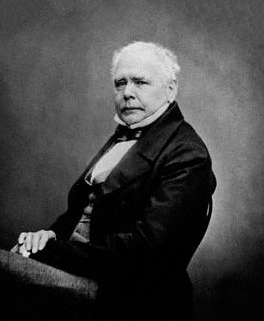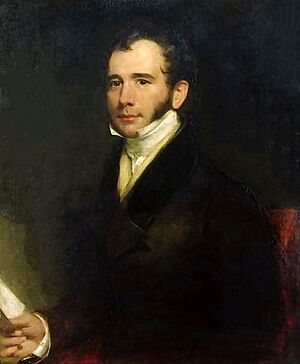William Thomas Brande facts for kids
Quick facts for kids
William Thomas Brande
|
|
|---|---|
 |
|
| Born | 11 January 1788 London, England
|
| Died | 11 February 1866 (aged 78) Tunbridge Wells, England
|
| Known for | Isolation of lithium Studies on alcohol |
| Awards | Bakerian Medal (1813, 1819) Copley Medal (1813) FRS (1809) |
| Scientific career | |
| Fields | Chemistry |
| Influenced | Michael Faraday |
William Thomas Brande (born January 11, 1788, died February 11, 1866) was an important English chemist. He is known for being the first to separate the element lithium. He also did important work on measuring the amount of a certain substance in different liquids. Brande taught chemistry at the famous Royal Institution in London.
Contents
Early Life and Education
William Thomas Brande was born in London, England. He was the youngest of six children. His father, Augustus Everard Brande, was a pharmacist from Germany.
William went to school in Kensington and then in Westminster. After finishing school in 1802, he became an apprentice to his older brother. His brother was also a pharmacist. William planned to become a doctor.
He studied medicine at Great Windmill Street Medical School. He also studied at St George's Hospital. However, he soon became very interested in chemistry. This happened after he met a famous chemist named Humphry Davy.
A Career in Chemistry
Brande taught himself a lot about chemistry in his free time. Soon, he started giving his own lectures on the subject.
In 1811, he published his first important articles. These articles were about how to measure a specific substance in liquids like wine, cider, and ale. Before his work, scientists could only measure this substance in strong, distilled drinks. Brande's findings helped people understand that this substance was naturally present in many drinks.
In 1812, Brande became a professor of chemistry. He taught at the Apothecaries' Society. The next year, he took over from Sir Humphry Davy. He became the professor of chemistry at the Royal Institution in London.
Isolating Lithium
In 1821, Brande made a big discovery. He was the first person to separate the element lithium. He did this using a method called electrolysis. He used electricity to break down lithium oxide and get pure lithium.
Work at the Royal Mint
Around 1823, Brande started working more and more with the Royal Mint. The Royal Mint is where coins are made. He eventually became the Superintendent of the Coining and Die Department. This meant he was in charge of making coins and the tools used to stamp them.
Books and Lectures
William Thomas Brande wrote several popular books. His book Manual of Chemistry was first published in 1819. It was used by many people.
In 1842, he also published a Dictionary of Science, Literature and Art. He was working on a new version of this dictionary when he passed away.
Brande also gave many lectures. He was invited to give the Royal Institution Christmas Lectures several times. These lectures are famous for explaining science to young people. He gave lectures on topics like the Chemistry of the Gases and The Chemistry of the Atmosphere and the Ocean. He also spoke about The Elements of Organic Chemistry and The Chemistry of Coal.
Family and Death
In July 1818, William Brande married Anna Frederica Hatchett. Her father, Charles Hatchett, was also a well-known chemist.
William Thomas Brande died in Tunbridge Wells in 1866. He is buried in West Norwood Cemetery in London.
Images for kids



